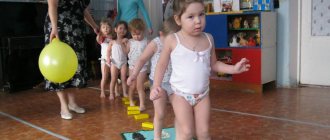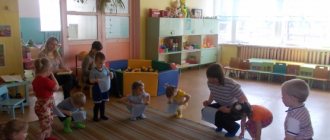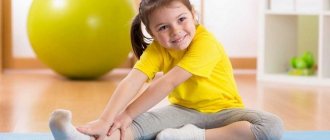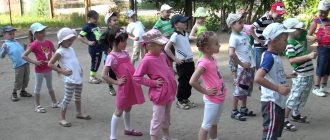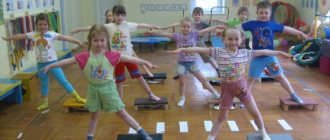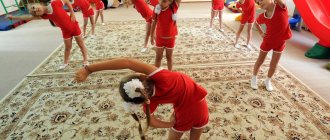Non-traditional forms of morning exercises in preschool educational institutions.
"Non-traditional forms of holding
morning exercises at preschool educational institutions"
The preschool period is the time when the foundation of physical, mental and moral health is laid. Among the many factors that influence the health and development of children, physical education occupies a special place in terms of intensity. In introducing children to a healthy lifestyle, their mastery of the basics of hygienic and physical education is of particular importance. The task of physical education of preschoolers is to form in them a stable habit of systematic physical exercise. Morning exercises play an important role in solving this problem. Although morning exercises in preschool educational institutions are short in time, they compensate for up to 5% of the daily volume of physical activity of children and are considered as an important element of the motor regime. Doing a set of morning exercises every day is the minimum physical activity that should become an element of every child’s personal physical culture. The special place of morning exercises in the daily routine is due to the important role that the transition from sleep to wakefulness, from rest to active activity plays in a person’s daily biological rhythm.
Analysis of previous work, the results of surveys and observations led to the conclusion that it is necessary to model morning exercises of a new type. Currently, many new methods of performing gymnastics have appeared. In order to increase children's interest in exercise, kindergarten teachers introduced non-traditional forms of morning exercises, such as:
— game stretching;
— step aerobics;
- gymnastics on fitballs.
Game stretching (application No. 3)
Game stretching
– these are specially selected muscle stretching exercises performed with children in a playful way. In other words, this is a creative activity in which children live in a world of images, often no less real to them than the surrounding reality.
The implementation of gaming opportunities for the health and development of the child is the essence of gaming stretching. Moreover, all classes are conducted in the form of a role-playing or thematic game, consisting of interrelated situations, tasks and exercises.
The method of play stretching is based on static stretching of the muscles of the body and the joint-ligamentous apparatus of the arms, legs, and spine, which allows one to prevent and correct postural disorders and have a profound healing effect on the entire body.
Exercises are performed without outside influence, because The human body is its own trainer. Self-manipulation of the body in a slow, and therefore safe, rhythm is most effective. In children, complexes associated with the physical imperfection of the body and the inability to control it disappear. In addition, children acquire a reserve of motor skills that allow them to feel strong, beautiful, self-confident, and create a sense of inner freedom.
Complex of morning exercises in the middle group “Snake and I are good friends!”
Complex of morning exercises using non-traditional equipment
“Snake and I are good friends!”
Fomina Victoria Vladimirovna
teacher
Name of the morning exercise complex:
“Snake and I are good friends!”
Age group:
middle group
Petrozavodsk urban district.
2017
A complex of morning exercises for the middle group.
“Snake and I are good friends!”
Equipment:
“hemp” (circles made of thick cardboard), “snakes” (green caps collected on a thread), tape recorder, recording the sound of a snake hissing, a cheerful musical composition.
Motivation of children:
- audio recording of snake hissing
- funny poem
- interesting non-traditional manual (“snakes”, “hemps”)
- the names of the exercises cover one topic
- low mobility game “A snake walked across the field”
- cheerful musical accompaniment
Introductory part:
Between the green grass,
Between old stumps, leaves and mushrooms,
Crawled, hissing into the bushes
The snake is a long string.
Walking in a column. Easy running. Walking like a snake, going around the “stumps”.
Children go around the “stumps”, at this time
The teacher turns on the sounds of a snake hissing and asks: “Who is that hissing?” (Children answer “snake”)
Main part:
- “Hello, snake!”
. I. p. - feet shoulder-width apart, hands folded behind the back. Take a breath. Lean forward. Exhale. Return to starting position. (1 - 2 times)
- “Pick up the snake.”
I. p. - stand with legs apart, “snake” at the bottom. 1 — lift the “snake” forward; 2 - up; 3 - forward; 4 - return to the starting position (5-6 times).
- “Put the snake down.”
I. p.: feet shoulder-width apart, “snake” below. Lean forward, lowering the “snake”, return to the starting position (5-6 times).
- “Show me the snake.”
I. p. - stand with feet shoulder-width apart, “snake” at the bottom. 1 — lift the “snake” forward; 2 - sit down, arms straight; 3 - stand up, “snake” forward; 4 - return to the starting position (5-6 times).
- "Jump over the snake."
I. p. - stand with legs slightly apart, arms at random, “snake” on the floor. Jumping on two legs over a snake. (5-6 times)
- Low mobility game “A snake walked across the field”
The “snake” walks in front of the players with the words: “The snake walked across the field and dropped its tail, (approaches one
of the players)
and then found it”
(touches the child’s “tail”).
The player must crawl between the legs of the “snake” and become its “tail”. And so on until all the children of the “tails” are collected.
Children take "snakes"
stand in a circle.
The “snakes” are placed on the stumps.
According to the counting rhyme, the driver is selected as a “snake”, and the rest of the guys are “tails” of the snake.
Final part:
Goodbye, snake! Crawl away quickly!
Your children are waiting for you
That's a loud name!
All the children, linked to each other (a long snake), walk around the hall. A short walk.
Breathing exercise
“We hiss like snakes”
Children say “sh – sh – sh – sh...”
The teacher turns on cheerful music.
Bibliography:
- FROM BIRTH TO SCHOOL. Basic educational program of preschool education / Ed. N.E, Veraksy, T.S. Komarova, M.A. Vasilyeva. – M.: MOSAIC-SYNTHESIS,
2015. - 368 p.
Photos of visual aids that were used during morning exercises.
Morning exercises in preschool educational institutions. Workshop for educators
“Modern approach to organizing and conducting morning exercises in preschool educational institutions”
Relevance: In light of solving the state’s priority task of preserving the health of the population, the main direction of work of preschool teachers is the preservation and strengthening of the health of preschool children. Morning exercises are included in a number of physical education and health activities of preschool educational institutions aimed at the full physical development and strengthening of children’s health. SEE ALSO Sets of exercises for children 3-4 years old Sets of exercises for children 4-5 years old Sets of exercises for children 5-6 years old Sets of exercises for children 6-7 years old Fascinating, selected in accordance with the age needs and capabilities of preschool children, morning exercises , contributes to the development of children's interest in physical education and sports, instilling in children a sense of purpose, organization, initiative, a desire to do physical exercise every day, and forms the foundations of a healthy lifestyle.
Purpose of the seminar:
- To acquaint teachers with modern techniques and approaches to conducting morning exercises in preschool educational institutions, aimed at preserving and strengthening the health of children, the successful formation and improvement of motor skills of preschoolers;
- To develop the ability of teachers to organize and conduct morning exercises, which arouses children’s interest in physical education and sports, developing the habit of a conscious attitude towards their own health and a healthy lifestyle.
Objectives of the seminar:
- Cover the tasks and importance of morning exercises for preschoolers
- Determine the content of morning exercises in accordance with the age needs and capabilities of preschoolers
- Present a methodology for conducting morning exercises with children of different age groups in the form of a master class by a physical education instructor
- Create exercise dosage tables for each age group
- Draw up a sample of planning morning exercises in accordance with the Federal State Educational Standard for Education.
Expected Result:
- Creation of a program and methodological base for advanced training of preschool teachers in this area
- Selection of the most appropriate methods for conducting morning exercises on the basis of preschool educational institutions
Practical significance:
- Methodological recommendations will allow preschool teachers to properly organize the planning and conduct of morning exercises
You can also download the seminar in the form of a presentation of 30 slides to the topic, the diagrams of formations for morning exercises have been added, it looks like this:
Objectives and importance of morning exercises
Gymnastics is a broad concept, defined as one of the main means and methods of comprehensive physical development.
Morning hygienic gymnastics aims to strengthen and preserve human health, create a cheerful, cheerful mood, and increase performance.
Morning exercises are a system of specially selected exercises that have a diversified effect on the human body, strengthening its basic functional processes, promoting its harmonious development and increasing vitality.
The purpose of morning exercises in kindergarten is to improve health, physical improvement and ensure the child’s versatile physical preparedness for a variety of activities.
Also, morning exercises in kindergarten have great educational significance. Systematic implementation of morning exercises instills in children the habit of doing physical exercise every day, teaches them to start the day in an organized manner, promotes strict adherence to the daily routine, teaches them to act consistently in a team, to be purposeful, attentive, self-controlled, and also evokes positive emotions and a joyful feeling.
Carrying out morning exercises in the fresh air or in a well-ventilated room helps to harden the child’s body and develop resistance to various environmental influences. The introduction of corrective exercises into complexes contributes to the formation of the arch of the foot and correct posture. Thus, morning exercises are a multifaceted physical education and health process that systematically improves the health of the child’s body.
Organization of morning exercises
Morning exercises are an obligatory part of the daily regimen and are carried out daily before breakfast, from spring to late autumn in good, dry weather, morning exercises are carried out outdoors on a group site. On those days when children are received in groups, morning exercises are carried out in the premises according to the morning exercises schedule. Before class, the room is ventilated; the optimal temperature for morning exercises in the room is 16 degrees. Children practice in casual clothes. Morning exercises in kindergarten are considered as an important element of the motor regime; by performing morning exercises, the child should receive an elevated emotional state and real joy of movement. There should be no forced gymnastics. If one of the children does not want to study today, there is no need to force him, the main thing is to subsequently understand the reason for this behavior and select individual forms of influence.
Structure of morning exercises
Like any physical education event, morning exercises begin with a warm-up and end with recovery exercises. Since morning exercises are not long, the physical activity involved is not great. Morning exercises consist of 3 parts:
- introductory
- main
- final
Each part has its own tasks and content.
3.1. Introductory part of morning exercises Objectives: organizing children's attention, focusing on performing coordinated actions; forming correct posture; preparing the body for performing more complex exercises.
3.2. The main part of morning exercises Tasks:
- strengthening major muscle groups
- formation of correct posture
The exercises are performed in a certain sequence: first, exercises are given to strengthen the shoulder girdle and arms, which contribute to the expansion of the chest, good straightening of the spine, and the development of the respiratory muscles; then exercises for the trunk muscles; This is followed by exercises to develop the leg muscles and strengthen the arch of the foot. After heavy-load exercises, you should repeat the first exercise or a similar one. The number of repetitions of each exercise depends on the age of the children and their physical fitness.
3.3. The final part of morning exercises Tasks:
- restore pulse and breathing
Content: Young children perform jumping or running moves that lead to a final walk. Older children perform jumping combined with running, then a final walk with various tasks. after the final walk, a sedentary game is played
Forms of morning exercises
Various forms of morning exercises are used:
- traditional form using general developmental exercises
- playing out some plot: “Journey to the Forest”, “Zoo”, “Bugs”, etc.
- gaming nature (from 3-4 outdoor games)
- using elements of rhythmic gymnastics, dance movements, round dances
- health running (carried out on a site for 3-5 minutes with a gradual increase in distance, intensity, time)
- using an obstacle course (you can create different obstacle courses using a variety of modules)
Requirements for sets of exercises for morning exercises
The combination of physical exercises, selected in a certain order, makes up a complex. Typically, a set of exercises for morning exercises is made up of exercises learned in physical education classes or from exercises that do not require lengthy learning. When compiling a complex, you must be guided by the following requirements:
- the complex should contain exercises for all muscle groups
- various formations are used in combination to perform exercises
- exercises should be performed from different starting positions
- exercises of varying intensity and tempo are selected
- complexes alternate with various aids and without items
- musical and rhythmic accompaniment is used (tambourine, counting, clapping, sound recording)
- each complex should be interesting to children
The same complex is repeated for one or two weeks. It must be remembered that the content of the morning exercise complex, as well as the dosage of exercises, are different for children of different age groups.
In order for morning exercises to have the desired effect on the child, it is important to achieve clarity, accuracy of the movements performed, and their sufficient intensity.
Methodology for morning exercises
To carry out health and educational tasks, morning exercises must be carried out at the exact time specified by the regime and correspond to the content of the program. The first requirement for it is the need to provide the correct physical, mental and emotional stress.
6.1 Morning exercises with children of primary preschool age
For the first time, morning exercises are included in the daily routine in the first junior group. Just like in other age groups, it is carried out at the beginning of the year every day with all the pupils of the group at the same time. Morning exercises at this age, in addition to the main task, provide an organized start to the day in kindergarten and make it possible to switch children’s attention to joint forms of activity.
Considering that many children at an early age do not immediately become involved in the activities organized by the teacher and lag behind in completing tasks, one should take a very subtle and differentiated approach to individual children, and not insist on the indispensable participation of everyone in morning exercises.
The introductory and final walking can be done in a group in a certain direction or in pairs, holding hands, scattered or behind each other. Walking should be calm and leisurely.
Then the children stand in a circle or sit in a free formation to perform general developmental exercises. At the beginning of the year, it is better to use a scattered formation, since children still have poor orientation. And it takes too much time to organize it into a certain form
Having lined up, children begin to perform exercises to strengthen the muscles of the shoulder girdle and arms, legs, back, abdomen and entire torso.
General developmental exercises are selected from among the exercises recommended for training. Almost all of them are imitative in nature and are carried out in a playful way. During morning exercises, sitting, lying on your back and on your stomach are widely used. In the second half of the year, small objects can be used for general developmental exercises: rattles, rings, cubes.
In conclusion, there should be running, jumping on the spot (2 times in 10-15 seconds with a short rest) or an outdoor game, well known to children, with very simple rules and content.
A gymnastics complex for children under 3 years old contains 3–4 general developmental exercises, the number of repetitions of each exercise is 4–5 times, it depends on the nature of the movements, their complexity and the preparedness of the children, its duration is up to 5 minutes.
A gymnastics complex for children from 3 to 4 years old contains 4 - 5 general developmental exercises, the number of repetitions of each exercise is 5 - 6 times, it depends on the nature of the movements, their complexity and the preparedness of the children, its duration is up to 5 - 6 minutes.
The complex of morning exercises is repeated without any special changes for 2 weeks in a row. When performing morning exercises, it is important to monitor the quality of children’s movements and the clarity of the recorded poses. By ensuring that the movement is similar to the model in general terms, the teacher ensures that it is performed in the specified manner. At an early age, exercises in morning gymnastics complexes are based on the actions of characters known to children (“Bunnies”, “Birds”, etc.). Throughout the gymnastics, the teacher acts together with the children, showing and explaining the exercises and the correct ways of movement. However, the teacher does not complete the exercises with the children. Having done it 2 - 3 times and setting the pace of execution, he continues to conduct the exercise verbally, while simultaneously observing the actions of the children, making the necessary instructions along the way.
When performing morning exercises, children of this age are characterized by dynamism and the presence of an extremely small number of completed, fixed positions. Almost all movements are performed sequentially. This determines the features of the explanation and demonstration of exercises. Only at the end of the third year of life does it become possible to use exercises that are not tied to a coherent plot
While doing the exercises, the teacher reminds the children when it is more appropriate to inhale and exhale, and makes sure that the children do not hold their breath while walking and running.
6.2 Morning exercises with middle-aged children
In the middle group, the importance of morning exercises remains to attract children's attention to collective forms of activity and for an organized start to the day in kindergarten. At the same time, its role in activating the functional activity of the child’s body is increasing. With children aged five years, morning exercises are carried out at a good, vigorous pace, without long pauses between exercises. The structure of morning exercises is the same. Morning exercises begin with a short walk, which should not be monotonous and boring. It is performed in any formation: one after another, in pairs, scattered, etc. Gradually, walking turns into light running, and running again into calm walking, during which a change in formation is carried out.
To perform a set of exercises at the beginning of the year, children most often stand in a circle. In the second half of the year, formation in links is used. The arrangement of general developmental exercises in the morning gymnastics complex does not change: first, exercises for the shoulder girdle and arms, then for the legs and torso. All kinds of general starting positions are used (standing, sitting, lying, kneeling) and different starting positions of the hands (to the sides, forward, etc.). The content of the complexes consists of exercises familiar to children. Exercises with objects are widely used.
A gymnastics complex for children from 4 to 5 years old contains 5–6 general developmental exercises, the number of repetitions of each exercise is 5–6 times, it depends on the nature of the movements, their complexity and the preparedness of the children, its duration is 6–7 minutes.
After general developmental exercises, jumping jacks are performed on the spot. They become more diverse: legs apart - legs together; with turns around; jumping back and forth over a tape lying on the floor; moving forward around the cubes. Dosage 15 – 20 jumps (1-2 times). They can be replaced by running in place or around the hall, turning into calm walking. Emotional play can be used.
If children are very excited after running and jumping, you need to let them calm down. For this purpose, calm walking in place or some breathing exercises are good (arms to the sides - inhale, lower your arms - exhale; arms down - back - inhale, lower your arms - exhale, the same, rising on your toes, etc.). It is necessary to remind and show children when it is convenient to inhale and exhale during exercises, and make sure that they do not hold their breath while running and jumping.
Each complex of morning exercises is repeated for 1 – 2 weeks. Some exercises may vary.
Leadership techniques.
The peculiarity of the explanation of the exercises is brevity and clarity. In some cases, you can resort to imitations. Explanations most often merge with demonstration, and the importance of the quality of the teacher’s demonstration increases. Clear starting positions and fixed intermediate positions are required (sitting - legs pulled up, knees together, closer to the chest, straightened, legs together, toes pulled back). The teacher gradually accustoms the children to act at the same time, in general, at a pace for everyone, and more persistently accustoms the children to the correct position of the body during exercises. The teacher only reminds you of the diagram of the exercise, the sequence of its parts, for example: “Put your legs wider, hands on your waist, bend forward. Let's start! One, two, three, straighten up.” And then, as the exercise progresses, without losing the rhythm of the movement, he continues his explanations, putting forward requirements for the correctness of the movement: “Lower, bend lower, look at me, straighten up. Let’s repeat it again,” says the teacher, leaving the group for a moment: he noticed that most of the children bend their legs while bending. – Keep your legs straight. One - two - three, lower, straighten up.” Thus, the teacher’s instructions accompany the execution of the exercise.
6.3. Morning exercises with children of senior preschool age
The main feature of morning exercises with children of senior preschool age is the responsible attitude of children to its implementation. For them, it is not necessary that it be entertaining and figurative. The teacher explains to the children the purpose of morning exercises, reveals its role in physical development, the acquisition of strength, agility, the formation of a good physique, a beautiful gait, etc.
Morning exercises are becoming a familiar form of daily physical culture. In preparing for it, children provide great assistance to the teacher: they gather their peers for morning exercises, prepare the necessary equipment, and vacate the room.
A gymnastics complex for children from 5 to 6 years old contains 5–6 general developmental exercises, the number of repetitions of each exercise is 6–7 times, it depends on the nature of the movements, their complexity and the preparedness of the children, its duration is up to 7–8 minutes.
A gymnastics complex for children from 6 to 7 years old contains 6–7 general developmental exercises, the number of repetitions of each exercise is 7–8 times, it depends on the nature of the movements, their complexity and the preparedness of the children, its duration is up to 8–10 minutes.
Walking exercises should be varied. Walking with a change of pace, direction, on the toes, heels, outer sides of the foot, raising the knees high, “goose” step, stepping over obstacles, etc., and attention exercises are widely used. All these exercises are carried out in different formations. They are not long and turn into an easy run. Running again turns into calm walking. And a rebuild is taking place. To perform these exercises, it is most convenient to form them into links. In the links, the children open up so as not to interfere with each other. A checkerboard formation is used, when the links take a step forward after one. For the convenience of performing exercises while sitting and lying down, it is advisable to turn all children half a turn to the right or left. Among the various starting positions in the second half of the year, the main stance (heels together, toes apart) is also used during morning exercises. As before, the starting positions for the hands are very different.
The volume of general developmental exercises without objects increases. Exercises with gymnastic sticks, hoops, and jump ropes are included. Jumping in place is varied by combinations of movements of the arms and legs, moving forward and backward, jumping over high objects, etc., repeated 20–30 times (1 or 2 times with a short break).
As in other groups, one set of morning exercises is carried out for 1 – 2 weeks. At his own discretion, the teacher can make clarifications and changes to it.
Leadership techniques.
During morning exercises, the teacher requires accuracy in the positions and directions of movement of body parts, and the ability to perform the exercise in accordance with the count or tempo of the musical accompaniment.
The quality of general developmental exercises is quite high. The teacher begins to teach children to stretch their legs, arms, fingers, pull their toes, stand, sit or lie in a given relaxed, but at the same time somewhat tense and taut pose. Children like to perform movements well and beautifully.
Since morning exercises use exercises known to children, their explanation has some specificity - it should be very clear and concise, in fact only reminding children of the starting position, the type of movement (bending, squatting, etc.), and the requirements for its quality.
Explanations of the exercise are combined with a demonstration of only the first days of mastering the complex. Moreover, the teacher widely involves children who have good command of movement in the demonstration.
Children of senior preschool age quickly remember the sequence of exercises in complexes. They successfully do them without the accompanying example of a teacher. As a last resort, they focus on the children in front or nearby. This allows the teacher not to be in front of the group all the time, but to walk between the rows of children, carefully observe each person’s exercise, and provide individual assistance. It is important not to lose track of the pace and rhythm of the counting that regulates the children’s joint actions.
Throughout the morning exercises, the teacher repeatedly draws attention to the children’s posture, reminding them of the need not to hold their breath, to breathe deeply, to coordinate inhalation and exhalation with the most appropriate phases of movement (arms to the sides - inhale, arms down - exhale, etc. ). Some exercises involve little natural tension. At the moment of such tension, there is a short breath holding while inhaling, then successive inhalation and exhalation.
Features of morning exercises in the air
In spring and summer, as a rule, morning exercises are carried out with children in all age groups on the site. The teacher regulates physical activity depending on the weather: when the temperature drops, it increases it, changing the pace of the exercise; when the temperature rises, it decreases to avoid overheating of the body.
In late autumn and winter, morning exercises can be carried out on the site, but only with children of the sixth year of life, and with the most physically prepared and seasoned children. Exercises are selected taking into account clothing and performed at a more energetic pace. Particular care must be taken to ensure that children do not get too cold.
Features of morning exercises using musical accompaniment
Morning exercises with musical accompaniment are carried out mainly in older age groups. Musical accompaniment of general developmental exercises is advisable if they are quite simple, well mastered by children and are performed by them freely and naturally. The child finds it difficult to act in accordance with the music. If he has poor movement skills. Therefore, any movement must first be learned with children without musical accompaniment. Of the general developmental exercises, the most convenient ones to perform while listening to music are arm movements, squats, bends, and turns.
First of all, movements such as walking, running, jumping in place and moving forward begin to the music. Under the influence of music they become clearer, rhythmic, and coordinated. With the help of music, you can change the pace, types of walking or running, alternate walking with running, change direction, etc.
Performing exercises to music helps to create correct ideas about the nature of movements, their tempo and rhythm. Children perceive the shades of a piece of music well and change the nature of their movements in accordance with the music. When the sound of cheerful music or marching sounds, they pull themselves up, walk briskly and cheerfully, raising their heads and straightening their backs. Walking becomes attractive and emotionally charged for them. Smooth, quiet music encourages you to walk calmly, with long strides. Fast, loud music encourages children to run, jump, a sudden end of music or an expressive chord serves as signals to stop or change movement, etc.
Musical accompaniment increases the expressiveness of motor actions, helps coordinate the movements of the team, increases the amplitude and plasticity of movements. Music disciplines students, increases their attention and performance. Positive emotions that arise during exercise to music enhance their physiological effect. The sound of music is most desirable at those moments in class when all the children are performing the same actions together at the same tempo and rhythm.
Some outdoor games with walking, running (“Day and Night”, “Sparrows and a Car”), jumping (“Horses”, “Hares and the Wolf”, etc.) are sometimes played to music.
To choose the right musical accompaniment, you need to have a good idea of each exercise, understand its meaning and purpose.
A number of exercises from a sitting position, lying on the back, on the stomach, the successful implementation of which depends on significant strength efforts and the individual capabilities of each child (bending, raising and lowering legs, etc.), are most often performed without musical accompaniment and even without counting.
Planning morning exercises
In order to achieve an effective effect of morning exercises on the child’s body, you need to draw up a plan - a summary, determine the sequence of exercises, think through and correctly write down the methodological instructions. At the same time, the teacher must remember about the ways of organizing children, the dosage and pace of exercises, methods of conducting them, the nature of the demonstration, explanations and instructions.
To give a correct assessment of your actions during morning exercises, you need to systematically monitor the quality of the exercises, the well-being of the children, and their behavior. Analyzing these behaviors, the teacher notes the positive aspects, identifies shortcomings and draws appropriate conclusions, and then makes changes to the complex of morning exercises and clarifies the methodology for its implementation.
SEE MORE Rules for recording general developmental exercises
